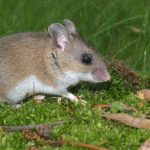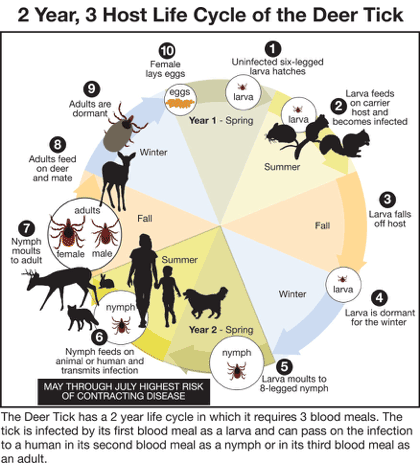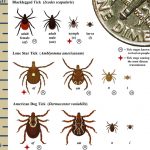Countryside Landscape & Design offers two Tick control options:
Damminix Tick Tubes® are specifically designed to target the mice population, and uses a minimal amount of pesticide to treat a large area. These tick tubes rely on the natural nesting instincts of mice, and deliver the tick controlling permethrin directly to this host animal.
Damminix Tick Tubes® are biodegradable, cardboard tubes filled with permethrin treated cotton balls. Tubes are placed at perimeter of property where mice and other rodents

Deer mouse
inhabit or travel (i.e.; property boundaries, in brush or woods, planting beds around buildings, landscaped planting beds, stone walls, under decks and porches). Mice collect the cotton to build their nests, in turn, Deer ticks that feed on the mice in the spring and fall are exposed to permethrin and killed.
Tube lifetime is 90 days.
(3 applications: April/July/October)
Tick FreeTM, is an organic insect control made from natural ingredients. Not only does it work for ticks, but also: gnats, fleas, ants, fire ants, spiders, chinch bugs, stink bugs and most exoskeleton insects.
The active ingredients are: cedar oil, which acts as a pheromone interruption agent that impairs the mental capacity of the insect and is the residual repellent for up to 30 days depending on the saturation. The cedar oil, when combined with the other active ingredient, 2-Phenethyl Propionate, a raspberry bio-solvent, causes the insect’s exoskeleton to erode and dehydrate. The fatty soap acts as a sticker to the insect, as well as allowing it to remain effective after rain.
(Applications: for heavy infestations, every 30 days; for moderate infestations every 60 days)
Living in the Berkshires, ticks and tick borne diseases have become an ever present reality. Ticks are tiny arachnids found in shady, damp, brushy, wooded, or grassy areas (especially in tall grass), including your own backyard. Ticks feed on the blood of mammals. Because of their habit of ingesting blood, ticks are vectors of at least twelve diseases that affect humans and other animals. In this area, most commonly the diseases are: Lyme, Anaplasmosis, Babesiosis, and Ehrlichiosis.
Being bitten by a tick is greater during specific times of the year when ticks are most active. The highest risk for contracting Lyme is May through July. Young ticks, called nymphs, are active from mid-May to mid-August and are about the size of poppy seeds. Adult ticks, which are approximately the size of sesame seeds, are most active from March to mid-May and from mid-August to November. Both nymphs and adults can transmit Lyme disease. Deer ticks have a two year life cycle that includes three feeding stages known as the larva, nymph and adult. Ticks can be active any time the temperature is above freezing. Harsh, abundant and long-lasting snow cover provides insulation that allows ticks to survive through the winter.

Ticks do not fly or jump. They attach to animals or people that come into direct contact with them. The best way to avoid ticks is to stay out of their habitat, but if they inhabit your lawn and outdoor areas, that can be hard to do. Most people think that Lyme infected deer ticks are infected from deer, but they actually are infected from mice.
MOSQUITO AND BITING FLY CONTROL SPRAY
(Application upon request: April through September. Recommended for events: weddings, outdoor gatherings, etc.)
This application is used to control the mosquito population, which are carriers of West Nile Virus, Eastern Equine Encephalitis, St. Louis Encephalitis and Dog Heartworm.
- West Nile Virus (WNV) cycles between birds and mosquitoes and then transmitted to mammals (including horses) and man by infected mosquitoes. Symptoms are characterized as flu-like; fever, headache, tiredness, aches or a rash. Symptoms can last a few days or several weeks, with some patients reporting them lasting over 30 days.
- Eastern Equine Encephalitis (EEE) is spread to horses and humans by infected mosquitoes, and is among the most serious of a group of mosquito-borne arboviruses that can affect the central nervous system, and cause severe complications, even death. Symptoms may range from none at all to a mild flu-like illness with fever, headache, and sore throat. More serious infections of the central nervous system lead to a sudden fever and severe headache followed quickly by seizures and coma. About half of these patients die from the disease. Survivors may suffer from permanent brain damage.
- St. Louis Encephalitis (SLE) is transmitted by infected mosquitoes from birds to humans and other mammals. Symptoms are similar to those in EEE.
- Dog Heartworm can be a life-threatening disease for canines and is caused by a roundworm transmitted via a mosquito. Heartworm is dependent on both the mammal and mosquito to fulfill its life cycle. The young worms (microfilaria) circulate in the blood stream of infected dogs. Mosquitoes become infected when they feed on the infected dog, and the worm continues its life cycle in the body of the mosquito. It eventually moves to the mouthpart of the mosquito as an infective larvae. When the mosquito feeds, it infects the victim it bites. Humans are an unsuitable host, and the worms usually die. Dogs cannot eliminate the worms, but the disease can be controlled through heartworm preventative measures.
MOSQUITO CONTROL LARVACIDE FOR PONDS
(recommended application: twice monthly April through October)
Controls mosquitoes in water bodies at their larval stage of development. It is safe for pets and kills mosquitoes by the thousands.
